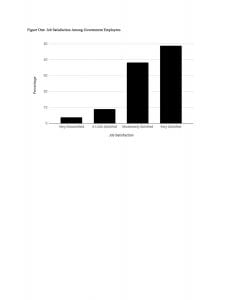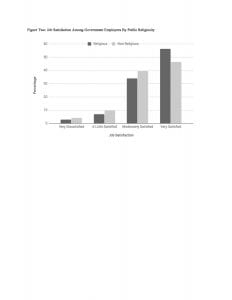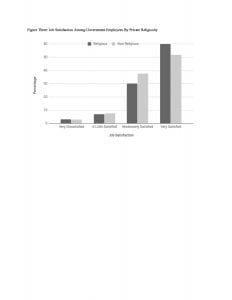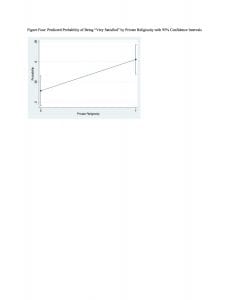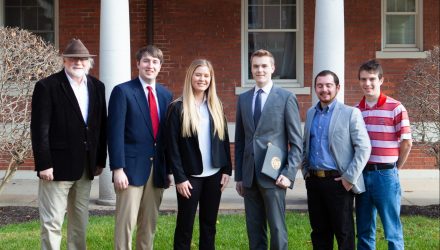
God in the Workplace

Abstract
Given the myriad positive effects of job satisfaction, analyzing its determinants continues to be a much-examined topic in public administration. Likewise, the work done on religiosity in the public sector suggests that faith is uniquely important among bureaucrats, but its direct effect on their jobs remains unexamined. This study brings together these fields to examine the role that religiosity plays in job satisfaction among public servants. Using a framework that integrates religion into the public sector workplace, it is hypothesized that religiosity will have a positive effect on job satisfaction. Drawing on data from the General Social Survey from 2000 to 2016, results from an ordered logit model support the hypothesis. This study demonstrates that faith does have a direct impact in the workplace, which has numerous implications for public administration, ranging from management practices to service delivery.
Introduction
Religion can cause tension in the workplace, especially within the public sector. Public managers often have to negotiate requests from employees concerning the exercise of their faith on the job, such as if and where public prayer may be allowed or how to accommodate religious dress. This reconciliation can even impact the implementation of policy, such as when a county clerk in Kentucky cited her religious beliefs when she ordered that her office would no longer issue marriage licenses.
However, while the interplay of religion and the public sector is a regular occurrence, there are still many questions in this field in the academic literature. For example, while it has been found that faith plays a heightened role among government workers, its direct effects on their jobs remains unexamined. Scholars have found that faith is not only more prevalent among those in the public sector, but that they are also more likely to want to incorporate their faith in their jobs (Houston & Cartwright, 2007; Freeman & Houston, 2010; Houston et al., 2008).
What scholars have not yet analyzed is the impact of that faith in their work. As a first step in this direction, this article examines the role of religiosity on job satisfaction among bureaucrats. Given the various positive behaviors associated with job satisfaction, any potential determinant of it merits detailed examination. Using a framework that focuses on the needs of the religious and the fulfillment of those needs, it is hypothesized that job satisfaction is higher among religious bureaucrats than non-religious bureaucrats.
To test this, data from the General Social Survey (GSS) covering a sixteen-year span from 2000 to 2016 was used. An ordered logit model found support for the hypothesis. Bureaucrats that were religious were more likely to say that they were very satisfied with their jobs than those that were not religious.
These results suggest that religiosity impacts how bureaucrats view their work. Therefore, it may be reasonable to next investigate if the actions of bureaucrats while on the job are also shaped by their faith. This could have important consequences for management as they learn how to best lead their workers. Furthermore, it should be better understood which types of bureaucrats may be more religious. Future studies may also wish to consider the behavioral implications of religion within the workplace.
The article will proceed as follows. The literature will be reviewed, followed by the presentation of the hypothesis. The data will then be described. The results will be examined, followed by a discussion of their implications and then a brief conclusion.
Literature Review and Hypothesis
Though defined in various ways, job satisfaction centers around the joy derived from labor. Spector (1997) labeled it as “the degree to which people like their jobs” (vii). In the realm of public administration, Jilke (2016) defined it as “…the outcome of employees’ individual expectations from their jobs and what they perceive they get” (374). Simply put, when scholars concern themselves with job satisfaction, they are focused on how much people enjoy what they do for a living.
There have been numerous studies on job satisfaction within both the private and public sector. From 2000-2018, hundreds of articles that discussed job satisfaction were published in peer-reviewed academic journals, based on a search of the term “job satisfaction” in the abstracts of peer-reviewed articles. As was noted by Jilke (2016), there have been almost a score of articles published annually on job satisfaction in public management since 2000.
Job satisfaction may be a popular research topic due to the number of positive attitudes and behaviors associated with it. Perhaps most notably, there is an association between job satisfaction and performance (Judge et al., 2001; Kim, 2005; Borgogni et al., 2010). Job 1 satisfaction is also associated with other behaviors, such as increased job commitment (Meyer et al., 2002) and decreased turnover intent (Tschopp et al., 2014).
There are also correlates of job satisfaction that are unique to the public sector. For example, satisfaction among public sector employees tends to be more strongly linked to affective and normative job commitment than private sector employees (Markovits et al., 2010). Additionally, those that are satisfied are less likely to want to switch to the private sector (Kankaanranta et al., 2007).
Given the positive outcomes associated with job satisfaction, it is unsurprising that there have been numerous studies trying to determine its causes. Within the public sector, scholars have analyzed several different types of determinants. Some have looked to individual-level factors, such as demographic characteristics (Jung et al., 2007) or personality traits (Cooper et al., 2014). Others have looked to more intermediate factors, such as organizational characteristics (Steijn 2004). There has also been a focus on more macro-factors, such as regime change (Jilke, 2016) or government budget cuts (Keifer, 2014). In one of the more comprehensive studies to date, Taylor and Westover (2011) found that public service motivation, intrinsic and extrinsic characteristics, and work relations all contribute to job satisfaction.
However, there remains a factor that has been largely neglected in the literature on job satisfaction: religiosity.
There have been few studies concerning religion in the public sector. Over the past twenty years, the number of articles concerning these two topics is less than a dozen. This may be due to the level of discomfort among public administrators in discussing faith. For example, in a survey of ASPA members, Bruce (2000) found that a majority believed that it was inappropriate to discuss spirituality in the profession of public administration. Among those that were not personally spiritual, this number was closer to eighty percent. As King (2007) wrote, “Once the idea of religion or spirituality is raised, public administration professionals – academic and practitioner alike – raise the red flag and wave it furiously…” (110).
Those articles in public administration that do discuss religiosity tend to cluster around similar themes. A few call on those in the public sector to use spiritual wisdom or the teachings of Jesus in public administration (Lynch & Lynch, 1999; deHaven-Smith, 2003). Others make preliminary observations on the role of spirituality among bureaucrats and urge more work to be done (Bruce, 2000; Lowery, 2005). In a broad look at this issue, King (2007) introduced a model that reconciled religiosity and spirituality in the private sector and suggested how it could be used in the public sector.
Some of the more quantitative approaches suggest both descriptive and practical effects of religiosity among public servants. Studies have shown that bureaucrats were generally more spiritual and more committed to their faith than those in the private sector (Houston & Freeman, 2007; Freeman & Houston, 2010). Beyond mere differences in practice, however, bureaucrats were also more likely to report that they try to carry their religious beliefs into the workplace than those in the private sector (Houston et al., 2008). This is in line with Lowery (2005), who noted in interviews with religious bureaucrats that they say that their faith informs their work. In other words, not only are bureaucrats more likely to be religious, they are also more likely to try to infuse their faith into their jobs than those working elsewhere. However, while bureaucrats may want to be guided by their faith in the workplace, studies have yet to show if they do . What remains to be analyzed is if faith has any direct impact on the work of those in the public sector that are religious.
What should be the expected effect of religiosity on the job satisfaction of bureaucrats?
For this, returning to the work of King (2007) may provide a suggestion. King (2007) sought a way to integrate religion and spirituality into the workplace. For this, he turned to the work of Nash and McLennan (2001) and their definition of “catalytic engagement” with religion.
Catalytic engagement defines religious practice as learning about or feeling the presence of God or some equivalent and then becoming “personally enhanced” because of it (Nash and McLennan 2001, 230). This is religiosity as an inflection point leading to transformation. This 2 is not religiosity manifesting itself in the form of proselytizing or by only relying on religious texts in moments of ethical quandary. Rather, this is religiosity as it alters concrete elements of the needs and perceived fulfillment of those needs within people. Catalytic engagement with
faith would allow religious believers to incorporate their religiosity into the workplace as they focus on fulfilling specific needs brought on by their beliefs. Based on this framework, which needs are altered by religiosity, and how could such needs be fulfilled in the public sector workplace? It has been shown that having a religious or spiritual experience can have myriad attitudinal effects, such as increased sense of “small self” or of spiritual humility (Preston and Shin 2017). Such religious experiences may also have behavioral effects, such as getting people to think beyond themselves and to focus on serving other people (Fredrickson 2002, Piedmont 1999). There is abundant evidence that those that are more religious are more likely to serve others, whether through helping neighbors or the homeless (Broosk 2006, Putnam and Campbell 2010), volunteering (Uslaner 2002, Ruiter and De Graff 2006, Putnam and Campbell 2010), or by being more civically active (Wald and Calhoun-Brown 2007, Smidt 2008). This suggests that there is a need among the religious to serve other people and that they seek to fulfill this need.
It is this “need to serve” that may connect religiosity to job satisfaction in the public sector. Public employees serve others by the very nature of their employment; their jobs directly focus on their communities. Religious bureaucrats may then fulfill this need to serve by working for the government. The need to serve others may be stronger among the religious, and work in the public sector serves others, so those that are religious should be more satisfied with their work than those that are not. Based on this, religiosity should have a positive effect on job satisfaction in the public sector.
Therefore, the following argument is made in this article. Bureaucrats have been found to be more religious than those in the private sector, but it remains to be seen how this directly impacts their work. Those that are religious are “personally enhanced” by a religious or spiritual experience. This “enhancement” leads to changes in the needs and perceived fulfillment of those needs in those people. One of those needs is a desire to serve the community. Working in the public sector gives those that are religious a chance to fulfill that need. Given that job satisfaction is defined as how much people enjoy what they do for a living, it is thus hypothesized that those that are religious in the public sector will have higher job satisfaction than those that are not. 3
H1: Job satisfaction will be higher among religious bureaucrats than non-religious bureaucrats.
Data and Methods
Data comes from the General Social Survey (GSS), a full-probability survey that conducts in-person interviews. The National Opinion Research Center at the University of Chicago has been administering the GSS since 1972. Alongside standard demographic questions, the survey also includes questions concerning other assorted and sundry topics. Based on the availability of questions, the data for this article comes from the surveys administered every other year from 2000 through 2016 for a total of nine different surveys. Given the nature of the question motivating this article, the sample will be limited to only include the responses from bureaucrats. To determine if a respondent is a bureaucrat, answers to the survey question, “Are you employed by the federal, state or local government or by a private employer (including non-profit organizations)” will be used.
The dependent variable is a measure of job satisfaction. The question used asks, “On the whole, how satisfied are you with the work that you do – would you say you are very satisfied, moderately satisfied, a little satisfied, or very dissatisfied?” Given the ordinal nature of the responses to the question, an ordered logit model will be used to model the data.
The key independent variable is a measure of religiosity. It has been long agreed upon in the literature that there are multiple dimensions to religiosity (Durkheim 1912; Stark and Glock 1968; Vaillancourt 2008); therefore, this analysis will use multiple measures in attempt to capture these dimensions. It has been argued by several scholars that religiosity can be collapsed into two categories: public and private (Wuthnow 1993; Graham and Haidt 2010; Van Tienen et 2011; Paxton et al. 2014). Public religiosity are those actions that others may witness, while private religiosity is concerned with more personal displays of devotion. In accordance with those studies, public religiosity will be measured as church attendance and private religiosity will be measured as frequency of prayer. 4
Next, these two categories have to be coded. The question used to public religiosity asked, “How often do you attend religious services?” Answers ranged from, “Never,” to, “More than once a week.” This variable was thus coded as days per year and then log transformed to reduce skew. Such a transformation is common in the literature (Lim and Putnam 2010; Paxton 5 et al. 2014). The question used to measure private religiosity asked, “About how often do you pray?” The answers to the question ranged from, “Never,” to “Several times a day.” Given that the responses do not allow for a differentiation between higher frequency of prayer (ex. someone who prayed twice a day and someone who prayed five times a day would be coded in the same category), the variable will be dummy coded, with those who pray at least once a day coded as 1 and all others as 0. This is also in keeping with the literature (Paxton et al. 2014). 6
Other independent variables will be used as controls in the model. In keeping with other recent work on job satisfaction in the public sector (Van Ryzin, 2014; Jilke, 2016), various demographic variables will be included, such as age, education, race, and sex. Both personal income and family income will be measured, as well as hours worked. The continuous variables will be age, personal income, and family income; the remaining variables will be dummy coded.
Descriptive statistics for the variables are available in the Appendix.
Results
First, the religiosity and faiths of those in the public sector will be examined. Concerning the public measure of religiosity, over 30% of bureaucrats attend church at least once a week. 7
This is over five percentage points greater than the number of those in the private sector that attend church at least once a week. For the private measure of religiosity, almost 60% of bureaucrats reported praying at least once a day, which is about three percentage points higher than those in the private sector. This is similar to the findings in earlier works that suggested that bureaucrats were more religious than others (Houston et al., 2008).
Table 1: Percentage Of Workers That Are Religious by Job Sector and Religiosity (n=1397)
Religiosity
Job Sector Public Private
Public Sector 30.38 61.27
Non-Public Sector 24.15 58.22
To what religions do bureaucrats belong? Among all bureaucrats in the sample, about 55% identified as Protestant, 22% as Catholic, 2% as Jewish, and 15% as “none,” meaning they did not identify with a specific faith, were atheist, or were agnostic. This distribution is slightly out of step with the rest of the country, but is in line with previous studies of religion in the public sector. According to a Pew Forum survey conducted in 2014, about 70% of Americans identify as Christian, with about 45% identifying as Protestant and 20% as Catholic (Pew 2014).
Around 6% identify with a non-Christian faith, with Jews occupying 2% of the total and the rest scattered among Muslims, Buddhists, Hindus, and other faiths. Those that are atheist, agnostic, or “nothing in particular” total over a fifth of the sample, with those falling in the latter category making up over 15% of the total sample. In summary, Christians, specifically Protestants, are overrepresented in the public sector, while the “nones” are underrepresented. This echoes the findings from earlier studies that found that bureaucrats were more likely to identify with a religion than those in the private sector (Houston & Freeman, 2007; Freeman & Houston, 2010).
The results in table 2 display the distribution of religious membership of bureaucrats among those who identify with a religion. The table shows that the sample is overwhelmingly Christian, with almost 95% identifying as such. More than 60% of the total sample identified as Protestant, with another almost 30% identified as Catholics. Around another 4% are either Orthodox-Christian, interdenominational or refer to themselves simply as “Christian.” Aside from Judaism, no other specific faith totals more than a percentage point.
Table 2: Faiths of Bureaucrats Who Identify With A Religion (n=1187) Name Percentage
Protestant 60.84
Catholic 28.75
Christian 3.63
Jewish 2.19
Other 1.33
Buddhism 0.84
Islam 0.61
Inter-Denominational 0.58
Orthodox-Christian 0.51
Hinduism 0.42
Other Eastern 0.18
Native American 0.13
Next, the distribution of job satisfaction among all bureaucrats will be reviewed. As can be seen in the following table, most bureaucrats are satisfied with their jobs. Almost half say that they are fully satisfied with their jobs. Less than 13% said that they were either a little satisfied
or very dissatisfied with their work.
Figure 1: Job Satisfaction Among Government Employees
Figure 2: Job Satisfaction Among Government Employees By Public Religiosity
Does this distribution change when the satisfaction of religious bureaucrats is analyzed separately? The following figures show the differences in satisfaction between religious and non-religious bureaucrats using each measure of religiosity. Those that attend church at least once a week appear to be less likely to say they are very dissatisfied, a little satisfied, or moderately satisfied with their jobs than those that are not religious. However, they appear to be almost 10 percentage points more likely to say that they are very satisfied with their jobs. This finding is echoed when considering the private measure of religiosity. While those that pray at least once a day are almost seven percentage points less likely to say that they are moderately satisfied with their jobs, they are about ten percentage points more likely to say that they are very satisfied. These figures provides prima facie support for the proposed hypothesis. While these results are suggestive, they do require additional analysis.
Figure 3: Job Satisfaction Among Government Employees By Private Religiosity
The results of the ordered logit model are described in the following table. Standard 8
errors are clustered by year. The impact of the control variables is in line with the rest of the
literature on job satisfaction; while age, sex, income, and education had no effect, being white
and working more hours tended to increase the odds of being satisfied. 9
Table 3: Ordered Logit Model of Job Satisfaction, 2000-2016 Variables Odds Ratio Std. Err.
Public Religiosity 1.02 0.04
Private Religiosity 1.40 0.15
White 1.84 0.25
Age 1.01 0.01
Male 0.97 0.08
College 0.82 0.09
Personal Income 1.01 0.03
Family Income 0.98 0.07
Work Hours 1.23 0.10
Cut One -2.63 1.04
Cut Two -1.20 1.12
Cut Three 0.88 1.16
N 1397
Pseudo R2 0.02
AIC 2616.82
BIC 2658.76 * Note: Variables significant at the 0.05-level are in bold
Most important, both measures of religiosity had a positive effect on job satisfaction.
Turning first to the public measure of religiosity, a one unit increase in the natural log of church attendance increases the odds of being very satisfied as opposed to being either moderately satisfied, a little satisfied, or very dissatisfied by 1.02, all else constant. With respect to the measure of private religiosity, moving from not praying at least once a day to praying at least once a day, the odds of being very satisfied as opposed to being either moderately satisfied, a little satisfied, or very dissatisfied are 1.40 greater, all else constant.
The effect of religiosity on job satisfaction is displayed graphically in the following figure. Those who do not pray at least once a day have a predicted probability of being very satisfied of 0.53, all else constant. For those that do pray at least once a day, that predicted probability moves to 0.61, all else constant. This helps demonstrate that the effect of religiosity on job satisfaction is both statistical and substantive.
Figure 4: Predicted Probability of Being “Very Satisfied” by Private Religiosity with 95% Confidence Intervals
Discussion
The results of this study suggest that religious bureaucrats are more likely to be satisfied with their jobs. Given the plethora of other variables that have also been found to exert an effect on job satisfaction, locating another relevant variable is notable. Additionally, finding that it has such an impact in the public sector is important, given the unique role played by government employees and the sorts of tasks they are given.
What are some of the implications of this finding? Since this study shows that religious beliefs do exert an effect in the workplace, figuring out what to do with this information is important. Those that are in the public sector will not be making hiring decisions based on religiosity, so the effects of religiosity need to be understood more in the context of management. For example, managers should make sure that the workplace is supportive of those that are religious. Pargament (2002) noted that when religious identity was not supported in the community, religious adherents may suffer emotional distress; this could carry over into the workplace.
The framework of catalytic engagement may be useful in examining these and other related questions. Managers may wish to look at the needs of their workers and see if and how the workplace can meet those needs. Borrowing the language from Klinger et al. (2015), focusing on need fulfillment may separate organizations from focusing on creating a “culture of commitment” to a “culture of compliance” (219).
To do this, managers may also wish to borrow ideas and language from the literature on diversity management. The findings from this paper suggest that religious public sector employees may have different needs than others. As was noted by Groeneveld (2011) in her study of diversity management, policies in the public sector workplace need to reflect the diverse needs and values of different groups of employees. Learning how to meet and fulfill those needs has tangible consequences for the workplace. For example, the successful implementation of diversity management can lead to an increased sense of well being (Mor Barak and Levin 2002).
There are other implications of this finding. Studies have long shown a link between job satisfaction and tenure (March & Simon, 1958; Dougherty et al., 1985; Brown & Peterson, 1993; Tschopp et al., 2014; Brawley & Pury, 2016). With increases in tenure normally come increases in power. Given that, it may be reasonable to assume that those bureaucrats who stay in their jobs the longest and have accrued more power and responsibilities may also be more religious than others, but such a claim would first merit investigation. How does religiosity impact how a bureaucrat executes her or his job? The implications of such an arrangement are ripe for future examination.
Additionally, little is known about which types of bureaucrats are religious. This study grouped together bureaucrats of all levels and all vocations. It is possible that some areas of government work may be more attractive to religious bureaucrats, but this needs to be determined. Are religious bureaucrats more likely to work in positions that are people-facing, or do they prefer to work in anonymity? Are religious bureaucrats more likely to want to work in their own communities, or do they want to serve the entire country? These and other questions remain to be explored.
In a similar vein, this study only focused on the United States. The religious composition of the US is changing; fewer people identify with any religion, while there has been growth in smaller faiths, such as Islam and Buddhism. Additionally, the idea of a separation of church and state is foundational to the country. What happens in bureaucracies where the government better resembles a theocracy? How might an adherence to a particular faith impact the delivery of services? These are other areas worthy of study.
Furthermore, this study only used two variables to measure religiosity. Other studies of religiosity have included question batteries or other variables to capture this multidimensional concept. While both church attendance and frequency of prayer are commonly used to measure religiosity, the use of other measurement techniques would serve to bolster these conclusions.
Conclusion
Scholars have long examined the causes and effects of job satisfaction in the public sector. However, the role of faith had yet to be incorporated into those studies. Based on prior work in the fields of religion and in public administration, it was hypothesized that increases in religiosity would increase job satisfaction. Using surveys covering an almost 20 year period, statistical models support the hypothesis, suggesting that those bureaucrats that were more religious tended to be more satisfied with their jobs.
For scholars, this article provides more support for the idea that bureaucrats may not be neutral instruments in their implementation of the law. Though Weber (1922, 2013) may have called for a neutral, rational administration, studies have shown the degree to which discretion and active representation shape the implementation of policies (Lipsky, 1980; Denhardt & deLeon, 1995; Sowa & Selden, 2003). Though they may have expressed some reservation in the past, scholars should not shy away from studying how faith may impact the delivery of government services.
For practitioners, this finding suggests that religion may play an important role in the work lives of their fellow bureaucrats. One of the implications of this is to make sure that the workplace remains a tolerant and respectful place for those of all religious persuasions.
Likewise, this may also encourage public servants to increase their knowledge of various faiths so that they may better understand their coworkers.
Bureaucracy remains an essential element to good governance. For many, religion remains an essential part of life. It is hoped that this study increases the understanding of these two oft-maligned, yet vital, entities.
Disclosure Statement
The author declares that there are no conflicts of interest that relate to the research, authorship, or publication of this article.
Appendix: Descriptive Statistics Variable Mean Std. Dev. Min Max N
Job Satisfaction 3.46 0.72 1 4 1397
Public Religiosity 2.36 1.74 -0.69 4.64 1397
Private Religiosity 0.66 0.47 0 1 1397
White 0.73 0.45 0 1 1397
Age 44.86 12.40 19 88 1397
Male 0.39 0.49 0 1 1397
College 0.43 0.50 0 1 1397
Personal Income 10.89 2.40 1 12 1397
Family Income 11.63 1.30 2 12 1397
Work Hours 0.20 0.40 0 1 1397
Author Biography
 Michael Bednarczuk is an Adjunct Instructor of Political Science at Ohio University – Chillicothe. His research has appeared in a variety of journals, including The American Review of Public Administration , Administration & Society , and Public Administration Quarterly .
Michael Bednarczuk is an Adjunct Instructor of Political Science at Ohio University – Chillicothe. His research has appeared in a variety of journals, including The American Review of Public Administration , Administration & Society , and Public Administration Quarterly .
References
Bachman, Jerald, Patrick O’Malley, John Schulenberg, lloyd Johnston, Alison Bryant, and Alicia Merline. 2002. The Decline in Substance Use in Young Adulthood: Changes in Social Activities, Roles, and Beliefs . Mahway, New Jersey: Lawrence Erlbaum Associates.
Barak, Michàl E. Mor, and Amy Levin. 2002. “Outside of the Corporate Mainstream and Excluded from the Work Community: A Study of Diversity, Job Satisfaction and Well-Being.” Community, Work & Family 5(2): 133-157. https://doi.org/10.1080/13668800220146346
Borgogni, Laura, Silvia Dello Russo, Laura Petitta, and Michele Vecchione. 2010. “Predicting Job Satisfaction and Job Performance in a Privatized Organization.” International Public Management Journal 13(3): 275-296. https://doi.org/10.1080/10967494.2010.504114
Brawley, Alice and Cynthia Pury. 2016. “Work Experiences on MTurk: Job Satisfaction, Turnover, and Information Sharing.” Computers in Human Behavior 54(1): 531-546. https://doi.org/10.1016/j.chb.2015.08.031
Brooks, Arthur C. 2007. Who Really Cares: The Surprising Truth About Compassionate Conservatism–America’s Charity Divide–Who Gives, Who Doesn’t, and Why it Matters . Basic Books (AZ).
Brown, Steven and Robert Peterson. 1993. “Antecedents and Consequences of Salesperson Job Satisfaction: Meta-Analysis and Assessment of Causal Effects.” Journal of Marketing Research 30(1): 63-77. https://doi.org/10.1177/002224379303000106
Bruce, Marino, David Martins, Kenrik Duru, Bettina Beech, Mario Sims, Nina Harawa, Roberto Vargas, Dulcie Kermah, Susanne Nicholas, Arleen Brown, and Keith Norris. 2017. “Church Attendance, Allostatic Load and Morality in Middle Aged Adults.” PLoS ONE 12(5): e0177618. https://doi.org/10.1371/journal.pone.0177618
Bruce, Willa. 2000. “Public Administrator Attitudes About Spirituality.” American Review of Public Administration 30(4): 460-472. https://doi.org/10.1177%2F02750740022064777
Cooper, Christopher, Dale Carpenter, Audrey Reiner and David McCord. 2014. “Personality and Job Satisfaction: Evidence from a Sample of Street-Level Bureaucrats.” International Journal of Public Administration 37(3): 155-162. https://doi.org/10.1080/01900692.2013.798810
Dahl, Robert. 1947. “The Science of Public Administration: Three Problems.” Public Administration Review 7(1): 1-11.
deHaven-Smith, Lance. 2003. “What Jesus Says to Public Administration.” International Journal of Organization Theory and Behavior 6(1): 90-118. https://doi.org/10.1108/IJOTB-06-01-2003-B001
DeJonge, Tineke, Ruut Veenhoven, Wim Kalmijn, and Lidia Arends. 2016. “Pooling Time Series Based on Slightly Different Questions About the Same Topic Forty Years of Survey Research on
Happiness and Life Satisfaction in The Netherlands.” Social Indicators Research 126(2): 863-891. https://doi.org/10.1007/s11205-015-0898-5
Denhardt, Robert and Linda deLeon 1995. “Greater Thinkers in Personnel Management.” In Handbook of Public Personnel Administration . New York, New York: Marcel Dekker.
Dougherty, Thomas, Allen Bluedorn, and Thomas Keon. 1985. “Precursors of Employee Turnover – A Multiple-Sample Causal-Analysis.” Journal of Occupational Behavior 6(4): 259-271. https://doi.org/10.1002/job.4030060404
Durkheim, Emile. 1995 [1912]. The Elementary Forms of Religious Life . Simon & Schuster.
Fredrickson, Barbara L. 2002. “How Does Religion Benefit Health and Well-Being? Are Positive Emotions Active Ingredients?.” Psychological Inquiry 13(3): 209-213. https://doi.org/10.1207/S15327965PLI1303_04
Freeman, Patricia and David Houston. 2010. “Belonging, Believing, Behaving: The Religious Character of Public Servants.” Administration & Society 42(6): 694-719. https://doi.org/10.1177%2F0095399710377981
Gerber, Alan, Jonathan Gruber, and Daniel Hungerman. 2016. “Does Church Attendance Cause People to Vote? Using Blue Laws’ Repeal to Estimate the Effect of Religiosity on Voter Turnout.” British Journal of Political Science 46(3): 481-500. https://doi.org/10.1017/S0007123414000416
Graham, Jesse, and Jonathan Haidt. 2010. “Beyond Beliefs: Religions Bind Individuals into Moral Communities.” Personality and Social Psychology Review 14(1): 140–150. https://doi.org/10.1177%2F1088868309353415
Groeneveld, Sandra. 2011. “Diversity and Employee Turnover in the Dutch Public Sector: Does Diversity Management Make a Difference?.” International Journal of Public Sector Management 24(6): 594-612. https://doi.org/10.1108/09513551111163675
Houston, David, Patricia Freeman and David Felman. 2008. “How Naked is the Public Square? Religion, Public Service, and Implications for Public Administration.” Public Administration Review 68(3): 428-444. https://doi.org/10.1111/j.1540-6210.2008.00880.x
Houston, David and Katherine Cartwright. 2007. “Spirituality and Public Service” Public Administration Review 67(1): 88-102. https://doi.org/10.1108/IJOTB-03-03-04-2000-B015
Jilke, Sebastian. 2016. “Job Satisfaction and Regime Change: Evidence from a Natural Experiment.” International Public Management Journal 19(3): 370-396. https://doi.org/10.1080/10967494.2015.1043168
Judge, Timothy, Joyce Bono, Carl Thoresen and Gregory Patton. 2001. “The Job Satisfaction-Job Performance Relationship: A Qualitative and Quantitative Review.” Psychological Bulletin 127(3): 376-407. http://dx.doi.org/10.1037/0033-2909.127.3.376
Jung, Kwangho, Jae Moon, and Sung Deuk Ham. 2007. “Do Age, Gender, and Sector Affect Job Satisfaction? Results From the Korean Labor and Income Panel Data.” Review of Public Personnel Administration 27(2): 125-146. https://doi.org/10.1177/0734371X06289229
Kankaanranta, Terhi, Tapio Nummi, Jari Vainiomaki, Hannu Halila, Harri Hyppola, Mauri Isokoski, Santero Kujala, Esko Kumpusalo, Kari Mattila, Irma Virjo, Jukka Vaska, and Pekka Rissanen. 2007. “The Role of Job Satisfaction, Job Dissatisfaction and Demographic Factors on Physicians’ Intentions to Switch Work Sector from Public to Private.” Health Policy 83(1): 50-64. 10.1016/j.healthpol.2006.11.010
Keaveney, Susan M., and James E. Nelson. 1993. “Coping with organizational role stress: Intrinsic motivational orientation, perceived role benefits, and psychological withdrawal.” Journal of the Academy of Marketing Science 21(2): 113-124. https://doi.org/10.1007/BF02894422
Keifer, Tina, Jean Hartley, Neil Conway and Rob Briner. 2014. “Feeling the Squeeze: Public Employees’ Experiences of Cutback- and Innovation-Related Organizational Changes Following a National Announcement of Budget Reduction.” Journal of Public Administration Research and Theory 25(4): 1279-1305. https://doi.org/10.1093/jopart/muu042
Kim, Sangmook. 2005. “Individual-Level Factors and Organizational Performance in Government Organizations.” Journal of Public Administration Research and Theory 15(2): 245-261. https://doi.org/10.1093/jopart/mui013
King, Stephen M. 2007. “Religion, spirituality, and the workplace: Challenges for public administration.” Public Administration Review 67(1): 103-114. https://doi.org/10.1111/j.1540-6210.2006.00700.x
Klingner, Donald E., Jared J. Llorens, and John Nalbandian. 2015. Public Personnel Management . Routledge.
Lim, Chaeyoon and Robert Putnam. 2010. “Religion, Social Networks, and Life Satisfaction.” American Sociological Review 75(6): 914-933. https://doi.org/10.1177/0003122410386686
Lipsky, Michael. 1980. Street-Level Bureaucracy: Dilemmas of the Individual in Public Service . New York, New York: Russell Sage Foundation.
Lowery, Daniel. 2005. “Self-Reflexivity: A Place for Religion and Spirituality in Public Administration.” Public Administration Review 65(3): 324-334. https://doi.org/10.1111/j.1540-6210.2005.00457.x
Lynch, Thomas and Cynthia Lynch. 1999. “Spiritual Wisdom and Public Administration: Are They Compatible?” International Journal of Organizational Theory and Behavior 2 (3&4): 273-302. https://doi.org/10.1108/IJOTB-02-03-04-1999-B002
Mafini, Chengedzai, and Nobukhosi Dlodlo. 2014. “The Relationship Between Extrinsic Motivation, Job Satisfaction and Life Satisfaction Amongst Employees in a Public Organisation.” SA Journal of Industrial Psychology 40(1): 1-12. https://doi.org/10.4102/sajip.v40i1.1166
March, James and Herbert Simon. 1958. Organizations . New York, New York: Wiley.
Markovits, Yannis, Ann Davis, Doris Fay and Rolf van Dick. 2010. “The Link Between Job Satisfaction and Organizational Commitment: Differences Between Public and Private Sector Employees” International Public Management Journal 13(2): 177-196. https://doi.org/10.1080/10967491003756682
Meyer, John, David Stanley, Lynne Herscovitch, and Laryssa Topolnytsky. 2002. “Affective, Continuance, and Normative Commitments to the Organization: A Meta-analysis of Antecedents, Correlates, and Consequences.” Journal of Vocational Behavior 61(1): 20-52. https://doi.org/10.1006/jvbe.2001.1842
Nash, Laura L., Scotty McLennan, and Kenneth H. Blanchard. 2001. Church on Sunday, Work on Monday: The Challenge of Fusing Christian Values with Business Life . San Francisco: Jossey-Bass.
Pargament, Kenneth I. 2001. The Psychology of Religion and Coping: Theory, Research, Practice . Guilford Press.
Pargament, Kenneth I. 2002. “The Bitter and the Sweet: An Evaluation of the Costs and Benefits of Religiousness.” Psychological inquiry 13(3): 168-181. http://dx.doi.org/10.1207/S15327965PLI1303_02
Paxton, Pamela, Nicholas E. Reith, and Jennifer L. Glanville. 2014. “Volunteering and the Dimensions of Religiosity: A Cross-National Analysis.” Review of Religious Research 56(4): 597-625. https://doi.org/10.1007/s13644-014-0169-y
Pew Research Center. 2014. Religious Landscape Study.
Piedmont, Ralph L. 1999. “Does Spirituality Represent the Sixth Factor of Personality? Spiritual Transcendence and the Five–Factor Model.” Journal of personality 67(6): 985-1013. http://dx.doi.org/10.1111/1467-6494.00080
Preston, Jesse L., and Faith Shin. 2017. “Spiritual Experiences Evoke Awe Through the Small Self in Both Religious and Non-Religious Individuals.” Journal of Experimental Social Psychology 70: 212-221. https://doi.org/10.1016/j.jesp.2016.11.006
Putnam, Robert D., and David E. Campbell. 2012. American Grace: How Religion Divides and Unites Us . Simon and Schuster.
Ruiter, Stijn, and Nan Dirk De Graaf. 2006. “National Context, Religiosity, and Volunteering: Results from 53 Countries.” American Sociological Review 71(2): 191-210. https://doi.org/10.1177/000312240607100202
Shore, Lynn McFarlane, and Harry J. Martin. 1989. “Job satisfaction and organizational commitment in relation to work performance and turnover intentions.” Human Relations 42(7): 625-638. https://doi.org/10.1177/001872678904200705
Smidt, Corwin E., Kevin R. den Dulk, James M. Penning, Stephen V. Monsma, and Douglas L. Koopman. 2008. Pews, Prayers, and Participation: Religion and Civic Responsibility in America . Georgetown University Press.
Sowa, Jessica and Sally Selden. 2003. “Administrative Discretion and Active Representation: An Expansion of the Theory of Representative Bureaucracy.” Public Administration Review 63(6): 700-710. https://doi.org/10.1111/1540-6210.00333
Spector, Paul. 1997. Job Satisfaction: Application, Assessment, Causes and Consequences . Thousand Oaks, CA: Sage Publications, Inc.
Stark, Rodney, and Charles Y. Glock. 1968. American Piety: The Nature of Religious Commitment . Berkeley: University of California Press.
Steijn, Bram. 2004. “Human Resource Management and Job Satisfaction in the Dutch Public Sector.” Review of Public Personnel Administration 24(4): 291-303. https://doi.org/10.1177/0734371X04269187
Taylor, Jeannette and Jonathan Westover. 2011. “Job Satisfaction in the Public Service.” Public Management Review 13(5): 731-751. https://doi.org/10.1177/0275074002250254
Tschopp, Cecile, Gudela Grote, and Marius Gerber. 2014. “How Career Orientation Shapes the Job Satisfaction-Turnover Intention Link.” Journal of Organizational Behavior 35(2): 151-171. https://doi.org/10.1002/job.1857
Unanue, Wenceslao, Marcos Gomez, Diego Cortez, Juan Oyanedel, and Andres Mendiburo-Seguel. 2017. “Revisiting the Link Between Job Satisfaction and Life Satisfaction: The Role of Basic Psychological Needs.” Frontiers in Psychology 8: 680. 10.3389/fpsyg.2017.00680
Uslaner, Eric M. 2002. “Religion and Civic Engagement in Canada and the United States.” Journal for the Scientific Study of Religion 41(2): 239-254. https://doi.org/10.1111/1468-5906.00114
Vaillancourt, Jean-Guy. 2008. “From Five to Ten Dimensions of Religion: Charles Y. Glock’s Dimensions of Religiosity Revisited.” Australian Religion Studies Review 21(1): 58–69. 10.1558/jasr.v21i1.58
Van Tienen, Marike, Peer Scheepers, Jan Reitsma, and Hans Schilderman. 2011. “The Role of Religiosity for Formal and Informal Volunteering in the Netherlands.” Voluntas: International Journal of Voluntary and Nonprofit Organizations 22(3): 365–389. https://doi.org/10.1007/s11266-010-9160-6
Wald, Kenneth D., and Allison Calhoun-Brown. 2014. Religion and Politics in the United States . Rowman & Littlefield.
Weber, Max. 1922, 2013. Economy and Society . Oakland, California: University of California Press.
Wright, Bradley. 2015. “The Science of Public Administration: Problems, Presumptions, Progress, and Possibilities.” Public Administration Review 75(6): 795-805. https://doi.org/10.1111/puar.12468
Wuthnow, Robert. 1993. Acts of Compassion: Caring for Others and Helping Ourselves . Princeton: Princeton University Press.
1 However, there are some studies in which job satisfaction had no effect on performance (Keavney and Nelson 1993, Shore and Martin 1989). Furthermore, the exact causal mechanism for the relationship between job satisfaction and job performance is still disputed (see Judge et al. 2001).
2 This is similar to Pargament’s (1997) conception of religion as “a search for significance in ways related to the sacred” (32), which includes objects such as community and work that are sacred due to their relation with a higher power.
3 It may also be argued that the religious will have higher job satisfaction because they view all of their work as a way of serving God. If this was the causal mechanism at work, then the effect of religiosity on job satisfaction should be the same across the private and the public sector. To test this, an additional model was run using private sector employees, and both the private sector and public sector models were then compared using seemingly unrelated regression. The effect of religiosity on job satisfaction was significantly larger in the public sector than in the private sector. This suggests that the effect of religiosity in the public sector is different from that in the private sector.
4 Tests showed that these variables should not be combined into one measure (ex. Cronbach’s alpha was less than 0.6), nor were they collinear, so they will be modeled as separate variables.
5 Other methods of scaling attendance, such as a dummy for those who attended at least once a week, were modeled and did not alter the substantive findings.
6 Other methods of scaling prayer, such as a categorical variable, were modeled and did not alter the substantive findings.
7 While this variable is coded as the natural log of the frequency of attendance at religious services in the statistical models used in this article, it is presented as a dummy in this descriptive section for ease of interpretation.
8 Other models were tested, such as a fixed effects model. Also, the analysis was re-run for every specific year. The results were robust across the various specifications.
9 It is possible that job satisfaction is confounded with life satisfaction. While it is suggested that the relationship between job and life satisfaction only runs from job satisfaction through life satisfaction in the public sector (Mafini and Dlodlo 2014), there are other studies that find a more reciprocal relationship across sectors (see Unanue et al. 2017). While there was not a measure of life satisfaction in the dataset, there was a measure of happiness, and these two measures have been shown to be highly related over time (DeJonge et al. 2016). This measure was included as an independent variable and the results were statistically and substantively unchanged, so it has been omitted.
Previous Post

